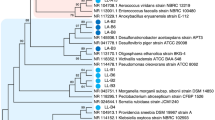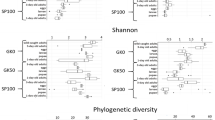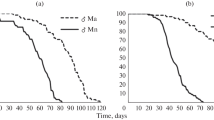Abstract
Microbiota has a significant impact on the health of the host individual. The complexity of the interactions between mammalian hosts and their microbiota highlights the value of using Drosophila melanogaster as a model organism, because of its relatively simple microbial community and ease of physiological and genetic manipulation. However, highly variable and sometimes inconsistent results regarding the microbiota of D. melanogaster have been reported for host samples collected from different geographical locations; discrepancies that may be because of the inherent physiological conditions of the D. melanogaster host. Here, we conducted a comparative analysis of the gut microbiota of two D. melanogaster laboratory strains, w 1118 and Canton S, with respect to the sex and age of the host, by pyrosequencing of the 16S rRNA gene. In addition to the widespread and abundant commensal bacterial genera Lactobacillus and Acetobacter, we identified Enterococcus and Leuconostoc as major host-strain-specific bacterial genera. The relative proportions of these bacterial genera, and those of the species within each, were found to differ markedly with respect to strain, sex, and age of the host, even though host individuals were reared under the same nutritional conditions. By using various bioinformatic tools, we uncovered several characteristic features of microbiota corresponding to specific categories of the flies: host-sex-bias association of specific bacteria, age-dependent alteration of microbiota across host species and sex, and uniqueness of the microbiota of female w 1118 flies. Our results, thus, help to further our understanding of host–microbe interactions in the D. melanogaster model.






Similar content being viewed by others
References
Hooper LV, Midtvedt T, Gordon JI (2002) How host-microbial interactions shape the nutrient environment of the mammalian intestine. Annu. Rev. Nutr. 22:283–307
Blumberg R, Powrie F (2012) Microbiota, disease, and back to health: a metastable journey. Sci Transl Med 4: 137rv137
Carding S, Verbeke K, Vipond DT, Corfe BM, Owen LJ (2015) Dysbiosis of the gut microbiota in disease. Microb. Ecol. Health Dis. 26:26191
Khan MT, Nieuwdorp M, Backhed F (2014) Microbial modulation of insulin sensitivity. Cell Metab. 20:753–760
Erkosar B, Leulier F (2014) Transient adult microbiota, gut homeostasis and longevity: novel insights from the drosophila model. FEBS Lett. 588:4250–4257
Erkosar B, Storelli G, Defaye A, Leulier F (2013) Host-intestinal microbiota mutualism: "learning on the fly". Cell Host Microbe 13:8–14
Wong AC, Vanhove AS, Watnick PI (2016) The interplay between intestinal bacteria and host metabolism in health and disease: lessons from Drosophila melanogaster. Dis Model Mech 9:271–281
Lhocine N, Ribeiro PS, Buchon N, Wepf A, Wilson R, Tenev T, Lemaitre B, Gstaiger M, Meier P, Leulier F (2008) PIMS modulates immune tolerance by negatively regulating drosophila innate immune signaling. Cell Host Microbe 4:147–158
Bosco-Drayon V, Poidevin M, Boneca IG, Narbonne-Reveau K, Royet J, Charroux B (2012) Peptidoglycan sensing by the receptor PGRP-LE in the drosophila gut induces immune responses to infectious bacteria and tolerance to microbiota. Cell Host Microbe 12:153–165
Bischoff V, Vignal C, Duvic B, Boneca IG, Hoffmann JA, Royet J (2006) Downregulation of the drosophila immune response by peptidoglycan-recognition proteins SC1 and SC2. PLoS Pathog. 2:e14
Buchon N, Broderick NA, Chakrabarti S, Lemaitre B (2009) Invasive and indigenous microbiota impact intestinal stem cell activity through multiple pathways in drosophila. Genes Dev. 23:2333–2344
Ha EM, Lee KA, Seo YY, Kim SH, Lim JH, Oh BH, Kim J, Lee WJ (2009) Coordination of multiple dual oxidase-regulatory pathways in responses to commensal and infectious microbes in drosophila gut. Nat. Immunol. 10:949–957
Paredes JC, Welchman DP, Poidevin M, Lemaitre B (2011) Negative regulation by amidase PGRPs shapes the drosophila antibacterial response and protects the fly from innocuous infection. Immunity 35:770–779
Ryu JH, Kim SH, Lee HY, Bai JY, Nam YD, Bae JW, Lee DG, Shin SC, Ha EM, Lee WJ (2008) Innate immune homeostasis by the homeobox gene caudal and commensal-gut mutualism in drosophila. Science 319:777–782
Guo L, Karpac J, Tran SL, Jasper H (2014) PGRP-SC2 promotes gut immune homeostasis to limit commensal dysbiosis and extend lifespan. Cell 156:109–122
Broderick NA, Lemaitre B (2012) Gut-associated microbes of Drosophila melanogaster. Gut Microbes 3:307–321
Shin SC, Kim SH, You H, Kim B, Kim AC, Lee KA, Yoon JH, Ryu JH, Lee WJ (2011) Drosophila microbiome modulates host developmental and metabolic homeostasis via insulin signaling. Science 334:670–674
Storelli G, Defaye A, Erkosar B, Hols P, Royet J, Leulier F (2011) Lactobacillus plantarum promotes drosophila systemic growth by modulating hormonal signals through TOR-dependent nutrient sensing. Cell Metab. 14:403–414
Cox CR, Gilmore MS (2007) Native microbial colonization of Drosophila melanogaster and its use as a model of Enterococcus faecalis pathogenesis. Infect. Immun. 75:1565–1576
Ren C, Webster P, Finkel SE, Tower J (2007) Increased internal and external bacterial load during drosophila aging without life-span trade-off. Cell Metab. 6:144–152
Wong CN, Ng P, Douglas AE (2011) Low-diversity bacterial community in the gut of the fruitfly Drosophila melanogaster. Environ. Microbiol. 13:1889–1900
Staubach F, Baines JF, Kunzel S, Bik EM, Petrov DA (2013) Host species and environmental effects on bacterial communities associated with drosophila in the laboratory and in the natural environment. PLoS One 8:e70749
Wong AC, Chaston JM, Douglas AE (2013) The inconstant gut microbiota of drosophila species revealed by 16S rRNA gene analysis. ISME J 7:1922–1932
Chandler JA, Lang JM, Bhatnagar S, Eisen JA, Kopp A (2011) Bacterial Communities of Diverse Drosophila Species: Ecological Context of a Host-Microbe Model System. Plos Genetics 7
Lee HJ, Jung JY, Oh YK, Lee SS, Madsen EL, Jeon CO (2012) Comparative survey of rumen microbial communities and metabolites across one caprine and three bovine groups, using bar-coded pyrosequencing and (1)H nuclear magnetic resonance spectroscopy. Appl. Environ. Microbiol. 78:5983–5993
Cole JR, Wang Q, Cardenas E, Fish J, Chai B, Farris RJ, Kulam-Syed-Mohideen AS, McGarrell DM, Marsh T, Garrity GM, Tiedje JM (2009) The ribosomal database project: improved alignments and new tools for rRNA analysis. Nucleic Acids Res. 37:D141–D145
Edgar RC (2010) Search and clustering orders of magnitude faster than BLAST. Bioinformatics 26:2460–2461
Schloss PD, Westcott SL, Ryabin T, Hall JR, Hartmann M, Hollister EB, Lesniewski RA, Oakley BB, Parks DH, Robinson CJ, Sahl JW, Stres B, Thallinger GG, Van Horn DJ, Weber CF (2009) Introducing mothur: open-source, platform-independent, community-supported software for describing and comparing microbial communities. Appl. Environ. Microbiol. 75:7537–7541
Shannon CE, Weaver W (1963) The mathematical theory of communication. University of Illinois Press, Urbana
Chao A (1987) Estimating the population size for capture-recapture data with unequal catchability. Biometrics 43:783–791
Segata N, Izard J, Waldron L, Gevers D, Miropolsky L, Garrett WS, Huttenhower C (2011) Metagenomic biomarker discovery and explanation. Genome Biol. 12:R60
Bray JR, Curtis JT (1957) An ordination of the upland forest communities of southern Wisconsin. Ecol. Monogr. 27:325–349
Newell PD, Chaston JM, Wang Y, Winans NJ, Sannino DR, Wong AC, Dobson AJ, Kagle J, Douglas AE (2014) In vivo function and comparative genomic analyses of the drosophila gut microbiota identify candidate symbiosis factors. Front. Microbiol. 5:576
Broderick NA, Buchon N, Lemaitre B (2014) Microbiota-induced changes in Drosophila melanogaster host gene expression and gut morphology. MBio 5:e01117–e01114
Newell PD, Douglas AE (2014) Interspecies interactions determine the impact of the gut microbiota on nutrient allocation in Drosophila melanogaster. Appl. Environ. Microbiol. 80:788–796
Lee KA, Kim SH, Kim EK, Ha EM, You H, Kim B, Kim MJ, Kwon Y, Ryu JH, Lee WJ (2013) Bacterial-derived uracil as a modulator of mucosal immunity and gut-microbe homeostasis in drosophila. Cell 153:797–811
Acknowledgments
We thank the Bloomington Drosophila Stock Center for the fly stocks used in this study. This research was supported by the Basic Science Research Program through the National Research Foundation of Korea (NRF), funded by the Ministry of Education, Science and Technology (Grant number: 2014R1A2A1A11052915) and by a grant from the Korea Health Technology R&D Project through the Korea Health Industry Development Institute (KHIDI), funded by the Ministry of Health & Welfare, Republic of Korea (Grant Number: HI14C2380).
Accession Number
The sequence data of the 16S rRNA genes from this study are publicly available in the NCBI Short Read Archive under accession no. SRP072269 (NCBI BioProject PRJNA316061).
Author information
Authors and Affiliations
Corresponding authors
Additional information
Gangsik Han and Hyo Jung Lee contributed equally to this study.
Rights and permissions
About this article
Cite this article
Han, G., Lee, H.J., Jeong, S.E. et al. Comparative Analysis of Drosophila melanogaster Gut Microbiota with Respect to Host Strain, Sex, and Age. Microb Ecol 74, 207–216 (2017). https://doi.org/10.1007/s00248-016-0925-3
Received:
Accepted:
Published:
Issue Date:
DOI: https://doi.org/10.1007/s00248-016-0925-3




